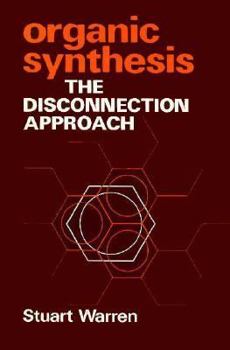Organic Synthesis: The Disconnection Approach
Select Format
Select Condition 
Book Overview
A workbook providing additional examples, problems, and solutions for use with Warren's Organic Synthesis: The Disconnection Approach. Exercises correspond to chapters in the main text. Problems of special ease or difficulty are labeled for optional use. Workbook includes a formula index of all target molecules contained in the text and workbook.
Format:Paperback
Language:English
ISBN:0471101613
ISBN13:9780471101611
Release Date:January 1991
Publisher:Wiley
Length:404 Pages
Weight:2.55 lbs.
Dimensions:0.9" x 6.0" x 9.0"
Customer Reviews
5 ratings
An excellent primer for any organic synthesis course.
Published by Thriftbooks.com User , 15 years ago
Warrens book "Organic Synthesis: The Disconnection Approach" serves as an excellent bridge between the elementary education received at the undergraduate level and the more complex problems faced by synthetic practitioners. Strictly speaking, the book does not stray much beyond the complement of reactions that are learned at the undergraduate level, so much of the chemistry should be familiar to anyone having taken a two semester course. The strength of this rather short book lies in its ability to identify synthetic challenges by analyzing the retrosynthetic disconnections that create them. Chapters alternate between the identification of a retrosynthetic disconnection and a discussion of a synthetic strategy. The book is valuable in that it distinguishes seemingly related compounds, such as 1,3-dicarbonyl compounds and 1,4-dicarbonyl compounds, and exposes the need for different synthetic strategies in each case - normal synthon polarity in the first case and inverse, or "umpolung", polarity in the second. Identifying relationships between functional groups in a molecule is presented as a means to determining possible strategies for its synthesis. Other important topics that are addressed include synthetic planning (order of events), stereochemistry, ring formation, reconnection, heterocycles, radical species, and many others. Overall, students should expect to gain competency in the retrosynthetic analysis of molecules of moderate complexity. The book overlooks many modern day methods, but prepares students well for a graduate level synthesis course that would include such methods and gives students a better appreciation for the problems these new methods address. In my opinion, it is one of the best introductions available. In combination with the recently published sequel "Organic Synthesis: Strategy and Control", which addresses many modern day strategies, an excellent foundation has been laid for the education of up-and-coming synthetic chemists.
Published 1991
Published by Thriftbooks.com User , 16 years ago
This book to me is better then the synthon approach book by Warren. This has more explanation than just, you do this to get this, and so forth. Again this book is most def for the graduate student, but don't be afraid to pick this up along with the workbook. Remember this not a "textbook" it is a book with a specific agenda, exactly what the title says.
Retrosynthetic Analysis
Published by Thriftbooks.com User , 22 years ago
Warren's Organic Synthesis-Disconnection Approach focuses on retrosynthetic analysis in organic synthesis. Some of the central concepts introduced in this strategy book are synthons, target molecule, FGI (functional group interconversion), disconnection, and reagent.Synthons: an idealized fragment, usually a cation or an anion, resulting from a disconnection. Synthons may or may not be an intermediate in the corresponding reaction.Disconnection: the reverse operation to a reaction. The imagined cleavage of a bond to "break" the molecule into possible starting materials.Functional group interconversion: the process of converting one functional group into another by substitution, addition, elimination, oxidation, or reduction, and the reverse operation used in retrosynthetic analysis.Reagent: Warren introduces a formal and rigid definition of reagent in this book. Reagent is a compound used in practice for a synthon. Warren's treatise of organic synthesis emphasizes visualizing and choosing not only the most obvious but the most efficient disconnection (retrosynthesis) in synthesizing a target molecule. The book is set up in a fashion such that synthetic strategies and organic reactions are presented in alternating chapters. Strategies aim to enforce tricks and concepts of organic synthesis like stereoselectivity, control of regiochemistry and stereochemistry, control of carbonyl condensation, order of events in synthesis, rearrangements, use of ringed molecules. Reaction chapters present some of the most significant reactions in organic synthesis, with an emphasis of those involve carbon-carbon formation. Topics of Warren's Organic Synthesis:Synthesis Strategies-The Disconnection Approach-The Order of Events-Chemoselectivity-Reversal of Polarity, Cyclization Reactions-Protecting Groups-Choosing a Disconnection (General Strategy)-Stereoselectivity-Regioselectivity-Use of Acetylenes-Introduction of Carbonyl Condensations-Control in Carbonyl Condensations-Use of Aliphatic Nitro Compounds in Synthesis-Radical Reactions in Synthesis-Reconnections-Introduction to Ring Synthesis, Saturated Heterocycles-Rearrangements in Synthesis-Use of Ketenes in Synthesis-Pericyclic Rearrangements in Synthesis-Special Methods for 5-Membered RingsReaction Methods-One Group C-X Disconnections-Two Group C-X Disconnections-Amine Synthesis-One Group C-C Disconnections: Alcohols-One Group C-C Disconnections: Carbonyl Compounds-Alkene Synthesis-Two Group Disconnections: Diels-Alder Reactions-Two Group Disconnections: 1,3-Difunctionalized Compounds and alpha,beta-unsaturated Carbonyl Compounds-Two Group Disconnections: 1,5-Difunctionalized Compounds, Michael Addition, Robinson Annulation-Two Group Disconnections: 1,2-Difunctionalized Compounds-Two Group Disconnections: 1,4-Difunctionalized Compounds-Two Group Disconnections: 1,6-Difunctionalized Compounds-Three-Membered Rings-Four-Membered Rings: Photochemistry in Synthesis-Five-Membered Rings-Six-Membered Rin
Retrosynthesis Primer
Published by Thriftbooks.com User , 24 years ago
The book treats the subject of organic retrosynthesis in a very clear fashion. It will be a perfect companion for students taking sunthetic organic chemistry course.
Thinking about synthesis
Published by Thriftbooks.com User , 26 years ago
Gets your mind thinking in the best way to make compounds. Instead of trying to remember hundreds of transformations, Warren's book shows you how to disconnect the compound into is smallest parts and how they could be put together. Basically, he discribes how to do retro-synthesis. Certainly another must for any medicinal or organic chemist.





